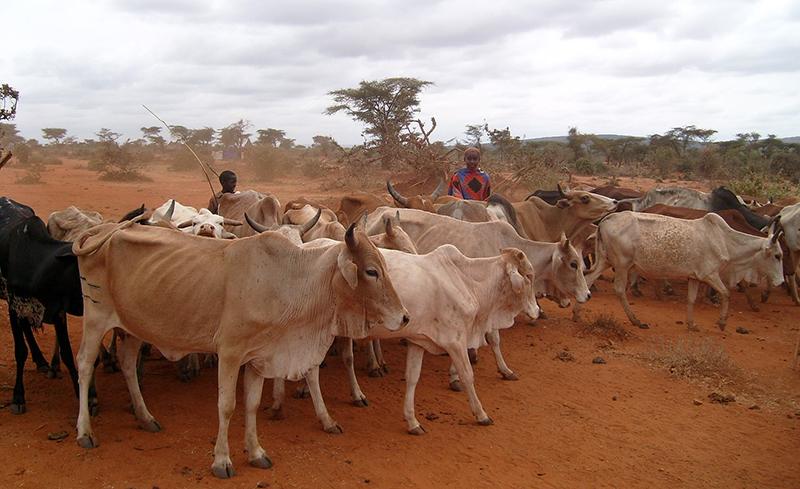
The concept of “resilience” is a cornerstone of international development strategies pursued by non-governmental organizations (NGOs) and governments alike in rural Africa, Asia, and Latin America. But what does the term mean? Although “resilience” has specific and well-established meanings in the fields of ecology, psychology, and engineering, it means something very different in the international development and humanitarian aid communities—though what precisely has been a matter of debate.
In a recent seminar presented at the National Socio-Environmental Synthesis Center (SESYNC), Christopher B. Barrett explained that while the concept of resilience is very popular in the field of international development, the fact that the term has never been explicitly defined means that no one agrees on how it should be measured.
Dr. Barrett, the Stephen B. & Janice G. Ashley Professor of Applied Economics and Management and an International Professor of Agriculture at the Charles H. Dyson School of Applied Economics and Management at Cornell University, identified three reasons why resilience has become important to the development community in recent years:
- Risk—whether from climate change, violence and conflict, or other stressors—is increasing, particularly in low- and middle-income countries.
- Crises have exposed longstanding difficulties in reconciling humanitarian responses, which focus on the moral obligation to safeguard human life, with development objectives, which focus on long-term improvements of living standards.
- There is a growing recognition of the interdependence of biophysical and socio-economic systems, especially in places where people are disproportionately dependent on natural systems for their livelihood and are thus vulnerable to natural shocks, such as droughts or floods.
One reason the term has been hard to define is due to the conflicting perceptions and expectations of various stakeholders.
“Humanitarian objectives, if you will, look down: they try to keep catastrophic things from happening,” Barrett explains. “Development objectives look forward: they try to advance progress, starting with living conditions.”
Further, as it is commonly formulated, resilience focuses on the stability of large systems, whereas the poor seek disruption because they desire to improve their living conditions. As a result of its malleability, the concept of resilience has therefore become intricately bound up in the complex issues of agency, power, and rights.
Barrett and others believe these competing perspectives can be reconciled. In order to accomplish such a synthesis, however, humanitarian and development experts must first establish a definition of resilience that incorporates theory and evidence. To that end, Barrett has developed a theory of resilience for international development applications (discussed in a 2014 article in the Proceedings of the National Academy of Sciences). From that theory, his research group is now developing an empirical model for using experimental and observational data over time to map the dynamics of individual well-being and use those estimates to generate quantitative measures of development resilience.
Barrett’s approach looks at the likelihood over time of people being non-poor as a product of the risks they have faced and are likely to face, their behaviors, and the unanticipated shocks they may encounter. In this approach, he says, “People can be said to have resilience if they have an adequately high probability of an adequately high standard of living.” Barrett’s model posits two thresholds, above which a person is considered resilient, and below which a person is considered at risk. Along the spectrum of resilience, there may be multiple stable states at which people can settle for long or short periods depending upon risks, behaviors, and shocks. Chronic poverty, he says, occupies an intermediate, undesirable stable state where people are neither at immediate risk of death nor thriving, and could be imperiled by sudden and unexpected changes.
To illustrate his theory and new measure, Barrett and his collaborators conducted a field experiment involving the development of an index-based livestock insurance (IBLI) product in Marsabit, Kenya, starting in early 2010. Barrett and his team conducted multiple rounds of household surveys to identify herders who were at risk of the kinds of instability that could cause them to fall into that intermediate state of chronic poverty and to determine whether IBLI would enhance their resilience. They used longitudinal data on mid-upper arm circumference (MUAC) in children aged five years or less to track well-being dynamics and estimate resilience in this population.
The results of the surveys were worrying: only 25 percent of the children in surveyed families were found to be resilient. However, the team found that livestock insurance helped build the resilience of the families that purchased it. These results not only provided assurance that livestock insurance works, but more importantly, argues Barrett, they provide a useful illustration of an implementable measure of resilience for international development applications.
Barrett explained that his model offers three possible approaches for programmatic interventions by humanitarian and development organizations:
- Shifting people’s current state to above-threshold conditions through education, land reform transfers, livestock gifts, or other asset transfers;
- Limiting people’s exposure to risk factors using methods of risk reduction, such as livestock or plant breeding for drought resistance, or methods of risk transfer, such as insurance and government safety nets; and
- Changing the underlying system structure to allow people to change their relationship to the system and grow their way out of poverty, such as through microfinancing.
By providing an empirical model of how individual well-being is affected by risks, behaviors, and shocks, Barrett’s work may lead to a more precise definition of resilience in the international development and humanitarian aid sectors.
The National Socio-Environmental Synthesis Center, funded through an award to the University of Maryland from the National Science Foundation, is a research center dedicated to accelerating scientific discovery at the interface of human and ecological systems. Visit us at www.sesync.org and follow us on Twitter @SESYNC.
Top image courtesy Christopher Barrett.